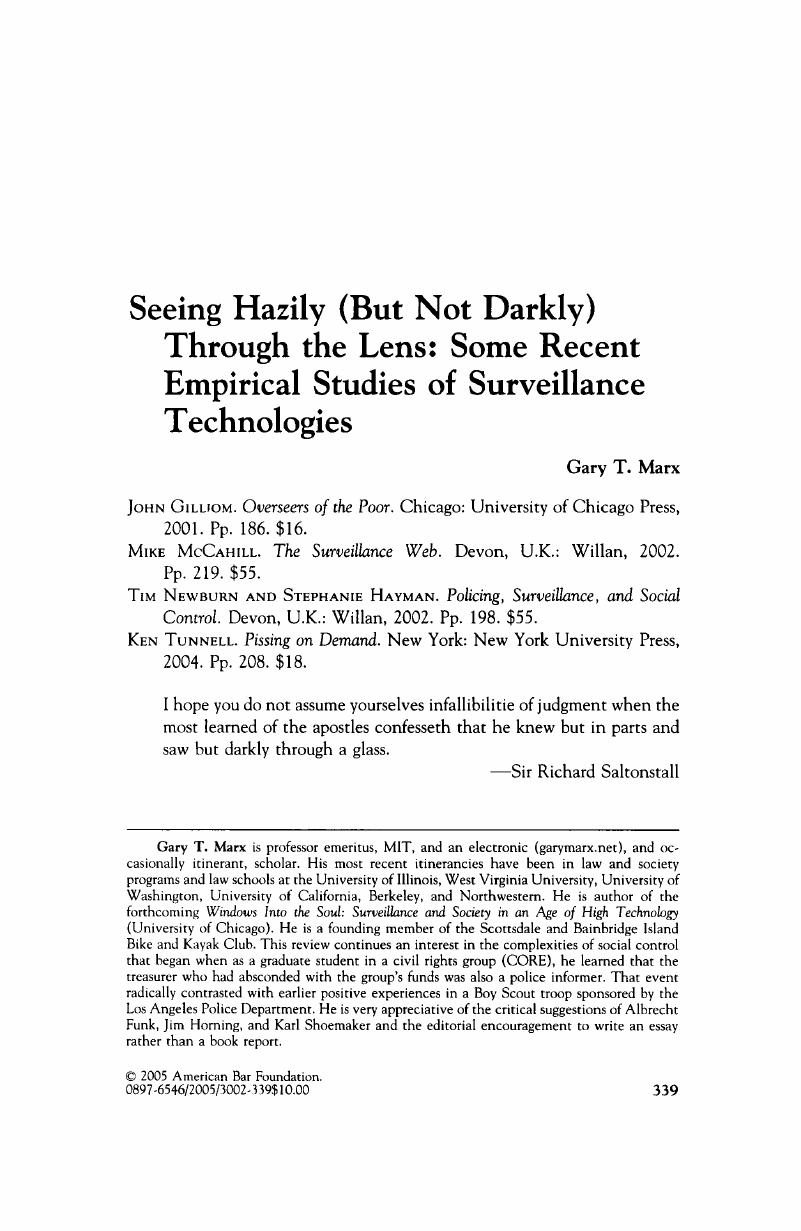Crossref Citations
This article has been cited by the following publications. This list is generated based on data provided by Crossref.
Marx, Gary T.
2006.
Mots et mondes de surveillance.
Criminologie,
Vol. 39,
Issue. 1,
p.
43.
Pleace, Nicholas
2007.
WORKLESS PEOPLE AND SURVEILLANT MASHUPS Social policy and data sharing in the UK.
Information, Communication & Society,
Vol. 10,
Issue. 6,
p.
943.
Hoffman, Steve G.
2007.
Simulation as a Social Process in Organizations.
Sociology Compass,
Vol. 1,
Issue. 2,
p.
613.
Marx, G.T.
2007.
Desperately Seeking Surveillance Studies: Players in Search of a Field.
Contemporary Sociology: A Journal of Reviews,
Vol. 36,
Issue. 2,
p.
125.
Marx, Gary T.
and
Muschert, Glenn W.
2007.
Personal Information, Borders, and the New Surveillance Studies.
Annual Review of Law and Social Science,
Vol. 3,
Issue. 1,
p.
375.
Dahl, Johanne Yttri
and
Sætnan, Ann Rudinow
2009.
“It all happened so slowly” – On controlling function creep in forensic DNA databases.
International Journal of Law, Crime and Justice,
Vol. 37,
Issue. 3,
p.
83.
Odella, Francesca
2013.
Human Behavior Recognition Technologies.
p.
225.
Agustina, José R.
and
Coudert, Fanny
2013.
Limits and challenges of the expanding use of covert CCTV in the workplace in Spain – beyond jurisprudential analysis.
Innovation: The European Journal of Social Science Research,
Vol. 26,
Issue. 1-2,
p.
145.
Cole, Benjamin M.
and
Banerjee, Preeta M.
2013.
Morally Contentious Technology-Field Intersections: The Case of Biotechnology in the United States.
Journal of Business Ethics,
Vol. 115,
Issue. 3,
p.
555.
Ravenscroft, Michael
2013.
Through a cracked lens: CCTV and the urban crisis in HBO’sThe Wire.
History and Technology,
Vol. 29,
Issue. 3,
p.
304.
Petonito, Gina
and
Muschert, Glenn W.
2015.
Handbook of Community Sentiment.
p.
253.
Sefiha, Ophir
and
Reichman, Nancy
2016.
When Every Test Is a Winner.
Journal of Sport and Social Issues,
Vol. 40,
Issue. 3,
p.
197.
Odella, Francesca
2016.
Technology Studies and the Sociological Debate on Monitoring of Social Interactions.
International Journal of Ambient Computing and Intelligence,
Vol. 7,
Issue. 1,
p.
1.
Odella, Francesca
2017.
Biometrics.
p.
529.
McQuade, Brendan
2018.
Windows into the Soul or the Clouded Glass of Surveillance Studies.
Critical Sociology,
Vol. 44,
Issue. 4-5,
p.
815.
Muñiz, Ana
2020.
Secondary ensnarement: Surveillance systems in the service of punitive immigration enforcement.
Punishment & Society,
Vol. 22,
Issue. 4,
p.
461.
Barriga, Antónia do Carmo
Martins, Ana Filipa
Simões, Maria João
and
Faustino, Délcio
2020.
The COVID-19 pandemic: Yet another catalyst for governmental mass surveillance?.
Social Sciences & Humanities Open,
Vol. 2,
Issue. 1,
p.
100096.
Power, Daniel J.
Heavin, Ciara
and
O’Connor, Yvonne
2021.
Balancing privacy rights and surveillance analytics: a decision process guide.
Journal of Business Analytics,
Vol. 4,
Issue. 2,
p.
155.
Evans-Jordan, Sarah B.
and
Skolbekken, John-Arne
2021.
Scientific Citizenship’s Youngest Domain: Function Creep in Norway’s Newborn Screening Programme.
Science, Technology and Society,
Vol. 26,
Issue. 1,
p.
98.
Atkinson, Colin
McBride, Maureen
and
Moore, Allan
2021.
Pitched! Informants and the covert policing of football fans in Scotland.
Policing and Society,
Vol. 31,
Issue. 7,
p.
863.



